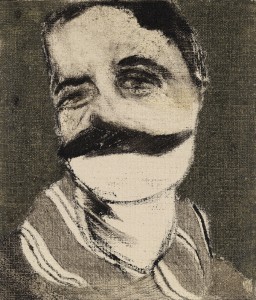R.B. Kitaj is known for his expressive, strongly-colored paintings and the retrospective at the Jewish Museum does these qualities full justice. Though for me personally, one of the most appealing works was at first unprepossessing. It is very small, barely 15 x 13 cm, in shades of grey – more a study than a painting. The Portrait of Aby Warburg (1958) depicts the pioneer of methodical iconography, who lived from 1866 to 1929. The son of a Hamburg banker, who passed on a career in the family business in order to become an artist and art historian, Warburg was an important inspiration for the painter Kitaj. Warburg studied the afterlife of ancient motifs in Renaissance art, an interest Kitaj shared insofar as he systematically quoted artworks from past eras in his own paintings.
As a template for the portrait, Kitaj use a photograph taken in 1896 in New Mexico when Warburg took part in a Native American Hopi snake-charming ritual. Next to the scarcely-dressed Hopi, Warburg looks out of place in his European suit with a watch-chain – a stranger in a strange land. Two details emerge, though, that disturb the impression of bourgeois respectability: he is wearing a kind of cowboy hat and a loosely-tied striped scarf. Kitaj accentuates these aspects of the photograph. He shows Warburg’s head without the hat, with shadowed eyes, the face dominated by an enormous mustache. He painted Warburg not as a dignified scholar but instead as a mix of nonchalant dandy and Mexican cowboy, who – so I fancy – smiles roguishly out at me: I’m not the person you took me for.
Henriette Kolb, Media
For more on R.B. Kitaj, see: www.jmberlin.de/kitaj/en
